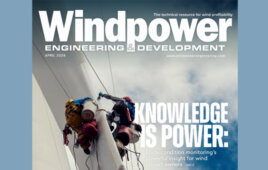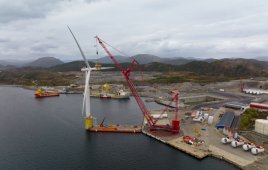By Bronwyn Sutton, Offshore Wind Principal; and Kim Connolly, Principal Engineer; Clir Renewables
As the world increases investment in the energy transition, companies in the sector are expanding from small teams of tens or hundreds to multinational offices with thousands of employees. However, unless these companies take an active role in promoting diversity and equity in recruitment and leadership opportunities, an early advantage in gender parity could start to disappear, as it becomes more difficult to recruit enough women from the already small pool of renewable energy talent.
 According to a report by the International Renewable Energy Association (IRENA), women make up 32% of all employees in the renewable energy industry, putting the sector ahead of conventional energy and technology for gender equality. Despite this, obstacles to women’s progression in renewable energy companies continue to hinder full gender parity – particularly in engineering and decision-making roles.
According to a report by the International Renewable Energy Association (IRENA), women make up 32% of all employees in the renewable energy industry, putting the sector ahead of conventional energy and technology for gender equality. Despite this, obstacles to women’s progression in renewable energy companies continue to hinder full gender parity – particularly in engineering and decision-making roles.
In our experience, we have found that women tend to make up 30 to 40% of the technical teams at small consultancies, with an even smaller proportion in senior management or board-level roles.
When it comes to engineering, it’s easy to believe that companies are simply hiring the best person for the job at hand, and seven out of 10 times, that person just happens to be a man. There is some truth to this – given the outdated but widespread societal assumptions that lead to a greater proportion of men than women entering practical or physical career paths, the pool of science, technology, engineering and math (STEM) candidates at the graduate level alone often skews very male. Add in unconscious biases on the part of hiring managers to recruit people who already seem to “fit in” with the team, and you can end up with an all-male department without intentionally limiting options for women.
Unequal representation of gender can be very difficult to rectify. For women entering a previously all-male team, it can be an isolating and, in the worst cases, actively hostile environment, making retention of female talent very difficult. Companies that aim to recruit women to solve a gender imbalance can further be accused of shutting out the most qualified candidates for the job.
 Complacency around a company’s gender balance can ultimately harm its ability to innovate and adapt to new circumstances. A key benefit of diversity in an organization is the wealth of experiences and perspectives from team members. Gender discrepancies in core STEM subjects at the degree-level can mean a less traditional route into the renewables industry for women, via education or experience in fields such as economics, geology, law and even policy. Employees bringing skills beyond traditional engineering help to create an environment ripe for innovation and cross-fertilization of ideas — vital as renewable energy businesses scale up into the new energy majors.
Complacency around a company’s gender balance can ultimately harm its ability to innovate and adapt to new circumstances. A key benefit of diversity in an organization is the wealth of experiences and perspectives from team members. Gender discrepancies in core STEM subjects at the degree-level can mean a less traditional route into the renewables industry for women, via education or experience in fields such as economics, geology, law and even policy. Employees bringing skills beyond traditional engineering help to create an environment ripe for innovation and cross-fertilization of ideas — vital as renewable energy businesses scale up into the new energy majors.
A more diverse organization is also useful in challenging practices that have persisted through tradition rather than tangible benefit to its employees.
Similarly, flexible and remote working policies have become invaluable for companies over the past year – and the businesses that already had the policies and technology in place were able to hit the ground running when these became a requirement rather than a bonus.
At Clir, we recognize that to take the lead in data innovation for the renewable energy industry, our company culture must foster diversity and thereby result in new ideas and approaches to common problems. Early in our company’s growth, we signed up to the Equal by 30 initiative, which challenges companies in the energy transition to achieve equal pay, equal leadership and equal opportunities for women by 2030.
Since May 2021, we have taken a further step and made tangible, clear commitments to embed a culture supportive of all of Clir’s employees. These include:
- Actively supporting flexible work hours, remote work, time off for mental health or stress leave for all staff.
- Supporting parents with offering flexibility in return to work, and support for family leave.
- Auditing ourselves annually to maintain accountability and refine our policies and processes, and participating in external audits to identify areas of improvement.
Additionally, we have updated our recruitment processes for diversity, including to hire and retain more women and provide them with the tools for progression. For example, we:
- Advertise jobs in communities/groups with a focus on minorities.
- Continue to use inclusive language when writing job ads.
- Aim to shortlist at least two qualified women for all positions.
- Aim to have 50% of internship roles filled by women.
- Have at least one female interviewer on hiring panels at all stages.
- Work to avoid a gender wage gap.
- Support employees with back-to-work policies after a long absence.
While we already exceed the industry average for number of women on all teams, with representation in 40.9% of our leadership roles as of January 2021, there is still work to do to reach full gender parity. The renewable energy industry cannot afford to let its early lead in equality slip. By making commitments to actively support and recruit women at all levels, we can ensure the energy transition does not entrench the same biases as the previous power system.
 Bronwyn Sutton previously led the wind advisory team at a top tier engineering consultancy, bringing more than a decade of commercial and transactional experience. She primarily works with blue chip lenders and investors on offshore wind assets and complex renewable portfolios. Bronwyn’s technocommercial experience and ability to interact with all stakeholders means sensitive and articulate delivery of material insights for project optimization.
Bronwyn Sutton previously led the wind advisory team at a top tier engineering consultancy, bringing more than a decade of commercial and transactional experience. She primarily works with blue chip lenders and investors on offshore wind assets and complex renewable portfolios. Bronwyn’s technocommercial experience and ability to interact with all stakeholders means sensitive and articulate delivery of material insights for project optimization.
 With 15 years of experience in the renewable industry, Kim Connolly has worked in many stages of a project lifecycle from development through to operations. She has extensive experience in turbine layout design, energy estimates and asset performance assessment on renewable projects in North America while working as consultant. In addition, Kim has held various positions on the owners side ranging from leading technical due diligence efforts as part of the business development team and managing all aspects of performance analytics and reporting in operations. Currently Kim is a Principal Engineer in Customer Success with Clir.
With 15 years of experience in the renewable industry, Kim Connolly has worked in many stages of a project lifecycle from development through to operations. She has extensive experience in turbine layout design, energy estimates and asset performance assessment on renewable projects in North America while working as consultant. In addition, Kim has held various positions on the owners side ranging from leading technical due diligence efforts as part of the business development team and managing all aspects of performance analytics and reporting in operations. Currently Kim is a Principal Engineer in Customer Success with Clir.
Filed Under: Featured




